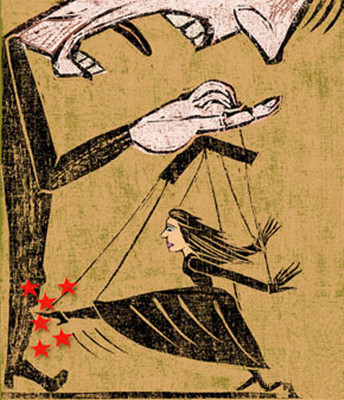18世紀(jì)的“窈窕淑女,君子好逑”
An inept Pygmalion
笨手笨腳的“皮格馬利翁”
A darkly amusing tale about the struggle to create the perfect wife
讓人苦笑的故事:努力為自己打造一個完美妻子
How to Create the Perfect Wife. By Wendy Moore.
《如何打造完美妻子》。作者:溫蒂·摩爾。
WENDY MOORE, a British historian, is developing a nice line in non-fiction 18th-century marital horror stories. “Wedlock”, her previous book, followed the misfortunes of a certain countess at the hands of her abusive husband, who gets his comeuppance to the cheers of every reader. Now, in “How to Create the Perfect Wife”, the man in question is not so obviously a villain and the woman never actually becomes his wife. But he certainly comes close, and she escapes by the skin of her teeth.
英國歷史家溫蒂·摩爾以十八世紀(jì)的婚姻故事為藍本,寫了一系列優(yōu)秀的悲情紀(jì)實小說。她之前的小說《婚姻》,講述的是某位公爵夫人受丈夫虐待折磨的悲慘人生。后來她丈夫得到了應(yīng)有的報應(yīng),讓每位讀者都拍手稱快。現(xiàn)在輪到了《如何打造完美妻子》,這位男主身上的惡人品性不是那么明顯,事實上女主也沒成為他的妻子。但他肯定和惡人差不多了,而她也差點兒陷入虎口。

Though less ripping than “Wedlock”, this story is told with gusto. At its centre is Thomas Day, a complex man. Heir to a large fortune, he abhorred fashionable society, denied himself every luxury and gave to the poor. He belonged to a group in Lichfield known as the “Lunar Men”, who believed in political reform and the rights of man. An early abolitionist, in 1773 he wrote a poem with his friend John Bicknell called “The Dying Negro”, which caused an anti-slavery sensation. Day was socially inept and uncouth, his hair unkempt, but he was generally admired for his honesty and idealism.
盡管沒有《婚姻》那么精彩,但人們卻可以從故事的字里行間中感受到作者寫作時的熱情。故事的中心是一個性格復(fù)雜的人—托馬斯·戴。雖然繼承了一大筆遺產(chǎn),但他憎惡上流社會,拒絕任何奢侈享受,還把錢財施舍給了窮人。他加入了利奇菲爾德一個叫“月球人”的組織。該組織支持政治改革、信仰人權(quán)。作為一名早期廢奴主義者,他在1773年和朋友約翰·比克內(nèi)爾寫了首詩,名為“即將消亡的黑人奴隸”,因此引發(fā)了一場反奴隸制的轟動。雖然在社交場合戴總是笨手笨腳、不懂禮數(shù),頭發(fā)也是亂蓬蓬的,但他卻因剛正不阿、樂觀理想受到眾人的敬重。
Apart from the bad hair, what's not to like? Alas, Day had a problem with women. He courted them, got engaged, but they all balked at the altar, unable to stomach his fierce virtue. Like his favourite philosopher, Jean-Jacques Rousseau, he blamed society for corrupting man's innate goodness. What Day needed was someone young and unformed, a Galatea to his Pygmalion. With Bicknell he hatched a scheme to solve his problems. They went to an orphanage, pretended to need a girl apprentice, picked out the prettiest and made off with her. Then they did it again at another orphanage.
除了糟糕的頭發(fā),還有什么理由不喜歡他呢?唉,他不太懂得如何與女人相處。他追求過幾個,也訂了婚,但一到神壇上她們就都退縮了,因為無法忍受他強烈的操守觀。就像他最喜歡的哲學(xué)家讓·雅克·盧梭一樣,戴怨社會侵蝕了人善良的天性。戴需要的是一個未定型的年輕女性—他這位“皮革馬利翁”的“伽拉特亞”。在比克內(nèi)爾的幫助下,他想出了一個解決自己問題的方案。他們?nèi)チ艘患夜聝涸海傺b是要收留一個女孩兒當(dāng)學(xué)徒。兩人選了最漂亮的一個,帶著她跑了。然后他們在另一家孤兒院又故伎重演。
Ann and Dorcas, aged 12 and 11, became Sabrina and Lucretia and began, without realising it, an educational programme designed to fit them for the role of Mrs Day. Unfortunately the programme involved some violence, as Rousseau believed in teaching fearlessness by way of pain and terror. Having chosen Sabrina once the girls hit puberty, Day worked to toughen her up by dripping sealing wax on her skin, standing her up to her neck in a lake and shooting bullets at her skirts.
12歲的安和11歲的多爾卡斯分別改名為薩布麗娜和盧克緹娜,開始接受教育培訓(xùn)。但她們沒意識到,這是為了日后能扮演好“戴夫人”這個角色而為之設(shè)計的。不幸的是,教育培訓(xùn)涉及一些暴力元素,這正是盧梭信仰的一套,通過肉體的疼痛和精神上的恫嚇來傳授無畏之道。兩個女孩兒到了青春期后,他選了薩布麗娜做未來的“戴夫人”。戴努力“訓(xùn)練”她:在她的皮膚上滴密封用的蠟油,讓她站在齊脖深的湖水中,向她的裙子開槍。
The whole experiment failed. Each girl rebelled. Lucretia married a draper and Sabrina married Bicknell.
整場實驗失敗了。兩個女孩兒都反抗了。盧克緹娜嫁給了一個布商,薩布麗娜嫁給了比克內(nèi)爾。
The story does not end there, but as far as Day is concerned, it has been told before. The real discovery here is Sabrina and her background. Some of the most fascinating parts of the book are about the foundling hospitals and orphanages of the period, and the unhappy mothers who gave up their babies to them. Ms Moore has combed the orphanage's archives, read the forms for each baby and seen the tokens left with them—a single earring, a piece of fabric, a playing card torn in half—in the hope of a future reunion. Sadly, stories of mothers rediscovering long-lost children were rare, the stuff of plays and novels.
故事到這里并沒有結(jié)束,但就戴而言,他的結(jié)局之前已經(jīng)提到了。此時真正浮出水面的卻是薩布麗娜和她的身世。本書最精彩的一部分是關(guān)于育嬰堂的劇情,以及那些傷心的母親把孩子丟在這兒的描述。摩爾女士翻遍了孤兒院的檔案記錄,看了每個孤兒的資料以及家人留給他們的紀(jì)念物—一個耳環(huán),一塊布,一個撕成兩半的紙牌。令人悲傷的是,母親找回失散多年孩子的故事少之又少,而且往往只出現(xiàn)在戲劇和小說里。












